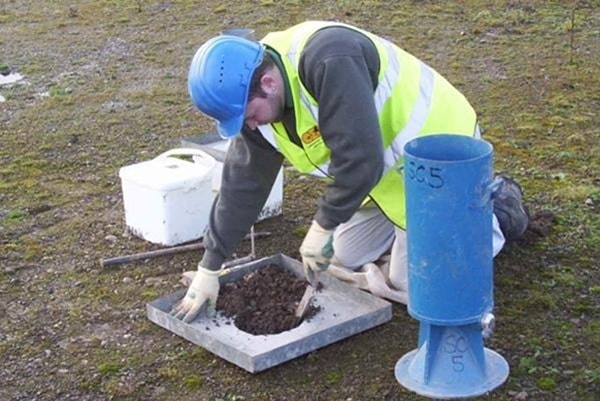Types of soil tests for road construction project requires the site investigation to be carried out to understand the soil profile. For road construction works, the properties of soil at subgrade level are required.The common soil test for road construction includes classification of soil, particle size distribution, moisture content determination, specific gravity, liquid limit and plastic limit tests. Moisture content, particle size and specific gravity tests on soils are used for the calculation of soil properties such as degree of saturation.
The soil tests can be laboratory tests or in-situ tests. The laboratory tests should be carried out on every sample taken for determination of particle size and moisture content.
 Types of Soil Tests for Road Construction:
Types of Soil Tests for Road Construction:
Following are the various types of soil tests for pavement construction:
In-situ Moisture Content
The moisture content of soil test is carried out in laboratory. It is expressed as percentage of water in soil to its dry mass. The moisture content in a soil signifies the various properties of soil such as compaction, permeability, particle size etc.
Specific gravity of soil
Specific gravity of soil is the ratio of the weight of soil in air of a given volume at a standard temperature to the weight in air of an equal volume of distilled water at the same stated temperature. This test is also carried out in laboratory.
Particle Size Distribution (By wet sieving & pipette method)
This test determines the particle size distribution of soil from the coarse sand size down to fine clay size. The data from particle size distribution test is used to determine suitability of soil for road construction, air field etc. This test can also be used to predict soil water movement although permeability tests are more generally used.
Compaction test – Proctor test
This soil compaction test also called as Proctor test is used for the determination of the mass of dry soil per cubic metre when the soil is compacted over a range of moisture contents, giving the maximum dry density at optimum moisture content. Thus this test provides the compaction characteristics of different soils with change in moisture content. This is achieved by densification of soil by reducing the air voids.
The degree of is measured in terms of its dry density of soil. The dry density is maximum at the optimum water content.
California Bearing Ratio (CBR) Test
California Bearing Ratio test is conducted in laboratory. This tests provides the load penetration resistance of soil. CBR value is obtained by measuring the relationship between force and penetration when a cylindrical plunger is made to penetrate the soil at a standard rate.
The CBR test is used for the evaluation of subgrade strength of roads and pavements. The CBR value obtained by this test is used with the empirical curves to determine the thickness of pavement and its component layers. This is the most widely used method for the design of flexible pavement.
Even though provision of subsoil drains reduces the effect of water on subgrade, fully soaked CBR tests shall be considered to be appropriate for road construction projects.
Following points should be taken care of while soil testing for road construction:
- Sampling and Testing: Sampling of soil for tests in laboratory or in-situ is to be carefully done by experienced engineer. The requirement for the various mass / volume of soil at different points of a road project shall be followed as per the specification and standard codes.
- Test Data Logging: Logging of all the soil sample and test data shall be done by trained staff who has the knowledge of soil properties and tests results.
- Testing Frequency: The testing frequency of soil shall be as per input from Engineer. The decision on the testing frequency is usually taken on the basis of results obtained from the previous tests.
Now ask any questions to Civil Engineers around the world.
Ask question